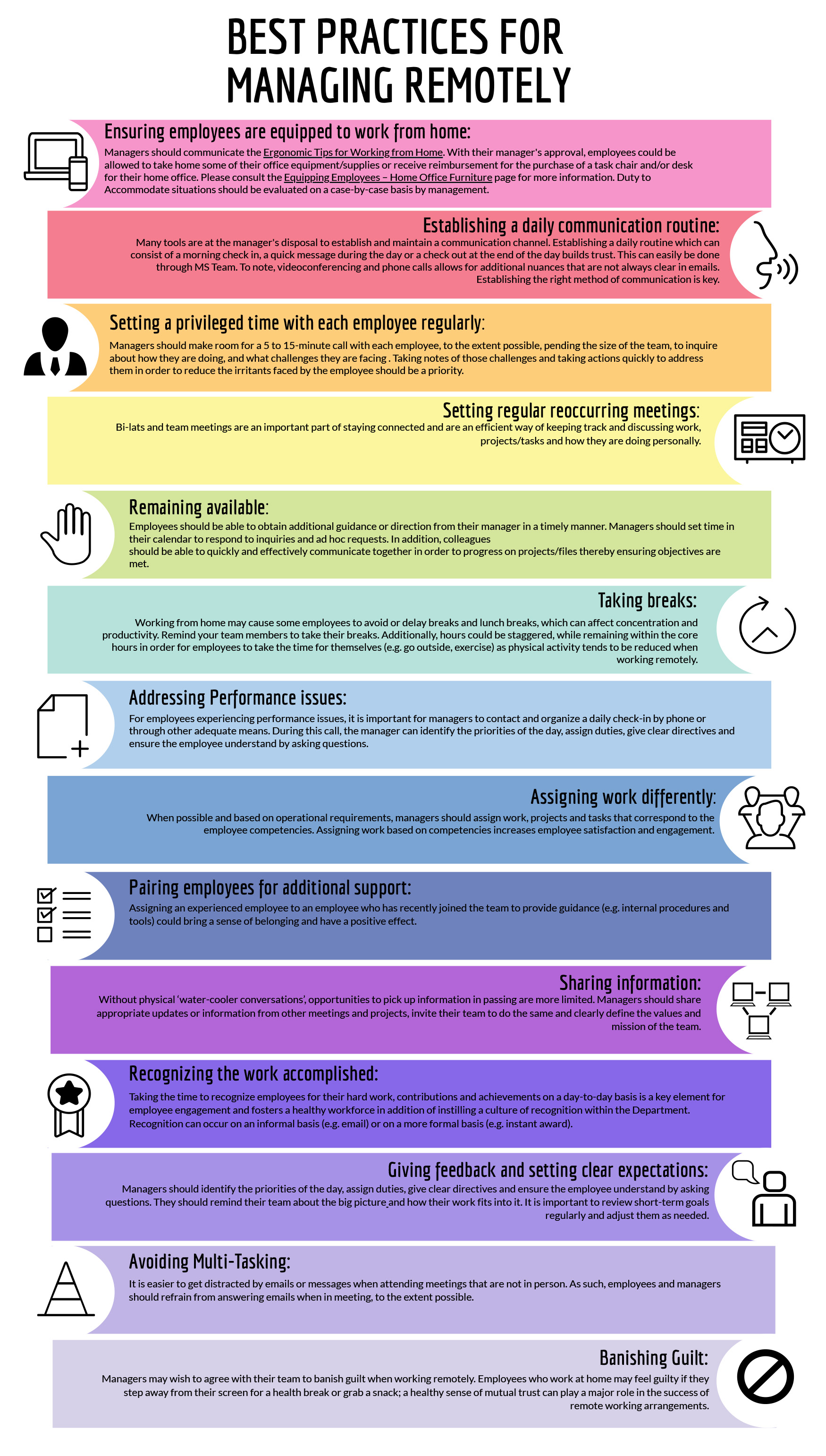Best Practices for Managing Remotely (Infographic)
Long description
Best practices for managing remotely
Ensuring employees are equipped to work from home:
Managers should communicate the Ergonomic Tips for Working from Home. With their manager's approval, employees could be allowed to take home some of their office equipment/supplies or receive reimbursement for the purchase of a task chair and/or desk for their home office. Please consult the Equipping Employees – Home Office Furniture page for more information. Duty to Accommodate situations should be evaluated on a case-by-case basis by management.
Establishing a daily communication routine:
Many tools are at the manager's disposal to establish and maintain a communication channel. Establishing a daily routine which can consist of a morning check in, a quick message during the day or a check out at the end of the day builds trust. This can easily be done through MS Team. To note, videoconferencing and phone calls allows for additional nuances that are not always clear in emails. Establishing the right method of communication is key.
Setting a privileged time with each employee regularly:
Managers should make room for a 5 to 15-minute call with each employee, to the extent possible, pending the size of the team, to inquire about how they are doing, and what challenges they are facing . Taking notes of those challenges and taking actions quickly to address them in order to reduce the irritants faced by the employee should be a priority.
Setting regular reoccurring meetings:
Bi-lats and team meetings are an important part of staying connected and are an efficient way of keeping track and discussing work, projects/tasks and how they are doing personally.
Remaining available:
Employees should be able to obtain additional guidance or direction from their manager in a timely manner. In addition, colleagues should be able to quickly and effectively communicate together in order to progress on projects/files thereby ensuring objectives are met.
Taking breaks:
Working from home may cause some employees to avoid or delay breaks and lunch breaks, which can affect concentration and productivity. Remind your team members to take their breaks. Additionally, hours could be staggered, while remaining within the core hours in order for employees to take the time for themselves (e.g. go outside, exercise) as physical activity tends to be reduced when working remotely.
Addressing Performance issues:
For employees experiencing performance issues, it is important for managers to contact and organize a daily check-in by phone or through other adequate means. During this call, the manager can identify the priorities of the day, assign duties, give clear directives and ensure the employee understand by asking questions.
Assigning work differently:
When possible and based on operational requirements, managers should assign work, projects and tasks that correspond to the employee competencies. Assigning work based on competencies increases employee satisfaction and engagement.
Pairing employees for additional support:
Assigning an experienced employee to an employee who has recently joined the team to provide guidance (e.g. internal procedures and tools) could bring a sense of belonging and have a positive effect.
Sharing information:
Without physical 'water-cooler conversations', opportunities to pick up information in passing are more limited. Managers should share appropriate updates or information from other meetings and projects, invite their team to do the same and clearly define the values and mission of the team.
Recognizing the work accomplished:
Taking the time to recognize employees for their hard work, contributions and achievements on a day-to-day basis is a key element for employee engagement and fosters a healthy workforce in addition of instilling a culture of recognition within the Department. Recognition can occur on an informal basis (e.g. email) or on a more formal basis (e.g. instant award).
Giving feedback and setting clear expectations:
Managers should identify the priorities of the day, assign duties, give clear directives and ensure the employee understand by asking questions. They should remind their team about the big picture and how their work fits into it. It is important to review short-term goals regularly and adjust them as needed.
Avoiding Multi-Tasking:
It is easier to get distracted by emails or messages when attending meetings that are not in person. As such, employees and managers should refrain from answering emails when in meeting, to the extent possible.
Banishing Guilt:
Managers may wish to agree with their team to banish guilt when working remotely. Employees who work at home may feel guilty if they step away from their screen for a health break or grab a snack; a healthy sense of mutual trust can play a major role in the success of remote working arrangements.
